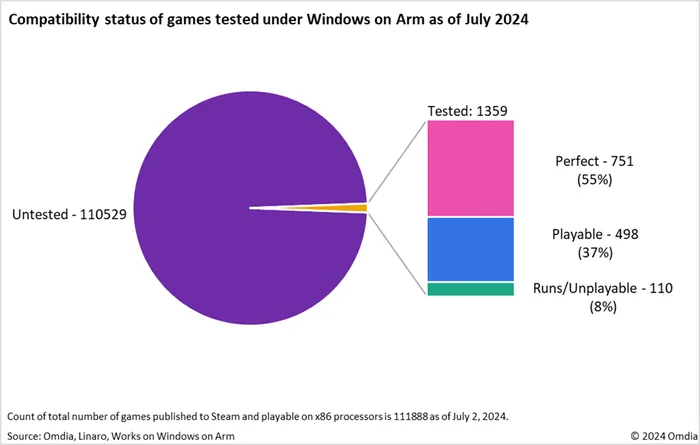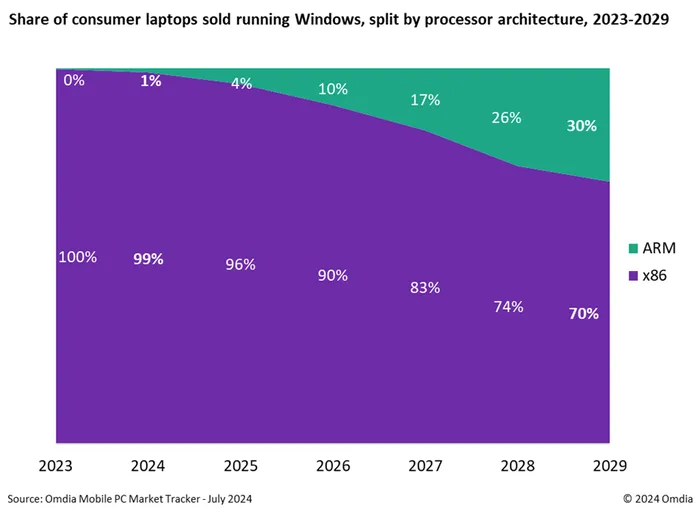The launch of Windows on Arm coincided with the arrival of Copilot+ PCs, devices that can implement Microsoft’s vision for the future of the Windows PC. Copilot+ PCs feature dedicated hardware that can run AI models on the device, unlocking new capabilities ranging from AI-powered generative content creation to automatic image upscaling for gaming.
For now, Copilot+ PCs are powered exclusively by Qualcomm’s Arm-based Snapdragon X hardware platform, with more than a dozen PC makers having already launched devices.
This new investment from Microsoft and its partners marks a significant milestone for Windows on Arm, which has so far enjoyed limited support. Previous-generation processors built on the Arm architecture were unable to compete with Intel and AMD’s x86-based processors, and software compatibility wasn’t robust enough to meet the needs of most users.
For example, Windows RT in 2012 only supported software specifically designed for Arm, leaving behind decades of Windows software that users still depended on. While Windows 10 improved the situation by supporting x86 software emulation, this didn’t extend to the increasingly dominant 64-bit software. At the same time, support for graphics-based applications was limited, making PC games inaccessible on Arm devices.
Fast forward to 2024 and Microsoft and Qualcomm have promised Arm devices that offer better power efficiency and higher performance than previous-generation x86 processors from AMD and Intel.
Microsoft has also developed an improved translation layer, called Prism, to improve Windows on Arm’s compatibility with x86 software. Qualcomm is so confident in Prism’s capabilities that it assured game developers at GDC 2024 that most of their games should work without any additional adjustments.
It’s an ambitious claim, given the x86 architecture’s massive library of native PC games – over 110,000 games have been released on Steam at the time of writing. For many, the PC platform is synonymous with backwards compatibility, as users invest in building a library of games over generations of PC ownership.
Gaming remains a major weakness of Windows on Arm
Despite Qualcomm’s big promises to game developers, gaming remains a major weakness of Windows on Arm, as compatibility with Windows’ massive PC game library remains spotty at best.
To date, just over 1,300 PC games have been independently tested for compatibility with Windows on Arm by the PC gaming community, which includes gamers and developers. Omdia’s analysis of this subset of tested games shows that just under half (55%) of the games run smoothly, without bugs or issues (see Figure 1). That leaves a large number of games that either don’t work or have serious issues.
Figure 1: About half of the titles currently tested have issues on Windows on Arm

Source: Omdia, Linaro, runs on Windows on Arm
To top it all off, popular multiplayer games such as League of Legends, Destiny 2, Fortnite, Apex Legends, And PUBG: Battlegrounds are currently unplayable via Windows on Arm due to incompatibility with anti-cheat software.
Another critical issue holding back robust gaming support is Qualcomm’s nascent hardware. Qualcomm’s Adreno GPUs are still in their infancy in the PC space. Its drivers are still immature and don’t allow its graphics hardware to fully meet the graphical demands of PC games, which poses an additional challenge in terms of compatibility and performance.
PC gaming has no immediate future on Arm
With much of publishers’ PC game catalogs left in various states of incompatibility, what can be done? The PC gaming landscape is defined not only by the publishers and developers who release games for the Windows operating system, but also by the hardware those games run on and the many distribution platforms on which the games are sold.
First, hardware: After Windows on Arm launched in June 2024, Arm-based Windows devices accounted for just 0.05% of Steam users according to Valve’s Steam Hardware Survey. Until mass adoption happens, game publishers have no incentive to produce native versions of their software.
This is unlikely to change in the short term. Mobile PC Market Monitoring Arm-based laptops are estimated to account for just 1% of consumer laptop shipments with Windows OS in 2024 (see Figure 2). However, over the longer term, this share is expected to reach 30% by 2029.
Figure 2: Sales volumes of consumer laptops with Arm processors are expected to remain weak in the near term

Source: Omdia Mobile PC Market Tracker – July 2024
Second, PC game distribution: even if publishers were producing Arm-native versions of their games today, the vast majority of them publish them through third-party distribution platforms. This creates its own set of problems.
Additionally, Microsoft does not support local playback of Xbox PC games on Arm devices via the pre-installed Xbox app on Windows 11. More importantly, Steam, the world’s largest PC game distribution platform, is firmly focused on serving the existing x86 audience, including its own portable gaming device, Steam Deck.
Publishers can’t distribute Arm versions of their software on Steam, and there’s no indication that this will change. This in turn reduces publishers’ incentive to better support the currently small audience of Windows on Arm, thereby reducing Steam’s incentive to support Arm devices.
The situation ultimately leaves game developers and publishers dependent on two key aspects of the Windows on Arm ecosystem that they don’t control: Microsoft’s Prism translation layer and Qualcomm’s graphics driver improvements.
None of these solutions are quick. In early 2024, Xbox president Sarah Bond announced the formation of a team dedicated to backwards compatibility for its games catalog, which spans PC and consoles. However, that task is unlikely to be accomplished until 2026 at the earliest.
In the meantime, it’s unlikely that Qualcomm’s graphics drivers will reach a level of robust compatibility with PC games for several years. As a new entrant in this space, the company will have to optimize its drivers on a game-by-game basis, which is time-consuming and expensive. Other hardware vendors like Nvidia entering the Windows on Arm space could improve the situation with their mature graphics drivers, but Omdia doesn’t expect that to happen until 2026.
Arm-based PC gaming faces a classic chicken-and-egg situation. Without a large enough and proven audience of Arm-based gamers, PC game publishers and distribution platforms have little incentive to support the Arm platform, putting the onus on companies like Microsoft and Qualcomm to improve compatibility to drive developer adoption.
In the meantime, PC game publishers and developers should focus on communicating what this means for their audience, using social media and game store pages to inform players and potential buyers about the level of playability they should expect if they were to use an Arm-based machine.
Despite Microsoft’s eagerness to put Arm at the heart of its new PC Copilot+ vision, the reality is that PC gaming enthusiasts will continue to favor PCs powered by the x86 architecture. While the move to Arm promises users lighter, more efficient PC hardware, the state of Arm-based PC gaming has a lot of catching up to do as the developer ecosystem is still in its infancy.